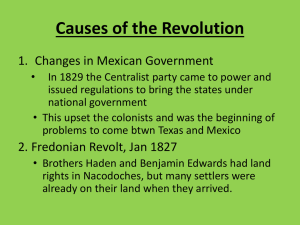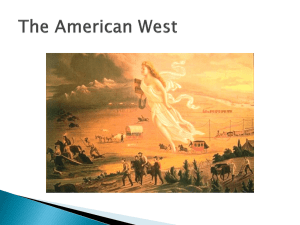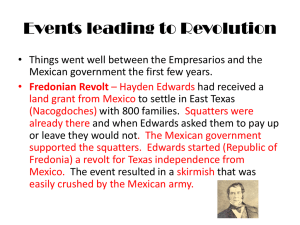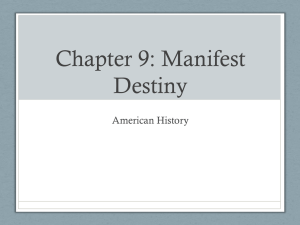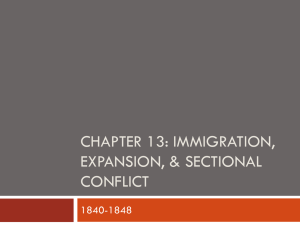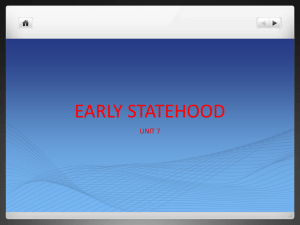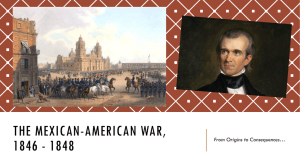Chapter 9: Expansion Leads to Conflict
advertisement
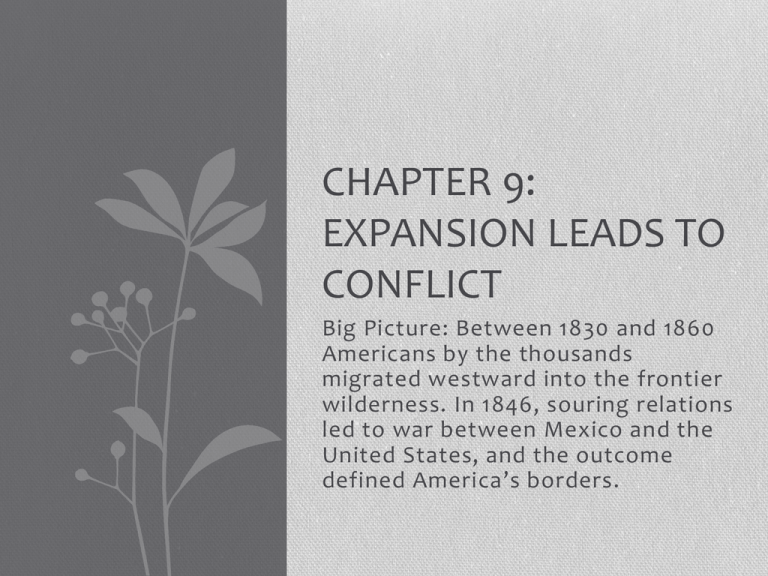
CHAPTER 9: EXPANSION LEADS TO CONFLICT Big Picture: Between 1830 and 1860 Americans by the thousands migrated westward into the frontier wilderness. In 1846, souring relations led to war between Mexico and the United States, and the outcome defined America’s borders. CHAPTER 9 SECTION 1: MANIFEST DESTINY Main Idea: Americans in large numbers followed trails to the West in the 1840s and 1850s Americans Head West Manifest Destiny Reasons to Migrate West • Population and size of country grew rapidly by the 1840s • Many Americans believed the idea that the nation had a Godgiven right to all of North America • Little thought was given to the impact on others of this belief • Believed in manifest destiny • Mountain men went to trap and trade • Missionaries hoped to convert Native Americans to Christianity • Lumberjacks and miners went to capitalize on natural resources • Farmers moved for vast, rich land • Entrepreneurs knew if they were first to set up shop the greater their chance for success Major Western Trails The Santa Fe Trail The Oregon Trail • 1st major western trail • 800-miles from Independence, MO to Santa Fe, NM • Began as a trade route • By the 1840s, it served as a route for migrants heading west • Longest and most famous • 2,000-miles from Independence, MO to Willamette Valley in OR • Parts of it used by Native Americans for centuries, Lewis and Clark used parts on their expedition, along with fur traders and mountain men • By the 1840s it was established as a major trail west The Mormon Trail • 1830, Joseph Smith founded the Church of Jesus Christ of Latter-day Saints in NY, called Mormons • In 5 years they attracted some 8,000 followers • They faced hostility for their beliefs, like men being able to have several wives • They migrated to area around Great Salt Lake (present-day Utah) with Brigham Young The Gold Rush Gold Fever Rush to California • Gold is discovered in the American River in 1848 many headed to CA to strike it rich! • Most in the US did not believe until President James K. Polk announced he believed the supply to be large and found in various places • The gold rush is the mass migration of miners and businesspeople to CA • The migrants that left for CA in 1849 were called forty-niners • More than 80,000 arrive • 80% are from the US • Most traveled over land; others booked passage on a ship Booming Cities • Upon reaching CA, most miners moved into mining camps in the gold fields • Others, especially businessmen, settled in the cities • San Francisco in 1848 had 800 people, one year later more than 25,000 • by 1860 it was home to some 60,000 people Major Effects of Westward Migration The Oregon Treaty Communication Links • James K. Polk, presidential candidate, campaigned to secure the region of OR for the US • “Fifty-four Forty or Fight!” was talking about the 54º40’ N latitude which marked the northern boundary of Oregon Country • Polk won presidency but retreated from his pledge and settled at the 49th parallel with Great Britain • Westward migration led to a need for better communication • Butterfield Trail, private stagecoach line ran • Pony Express, relied on young riders and fast horses • Telegraph linked East to West and made the Pony Express obsolete • The greatest effect was on the Native Americans whose life was changed forever. CHAPTER 9 SECTION 2: TEXAS INDEPENDENCE Main Idea: American settlers in Texas revolted against the Mexican government and created the independent Republic of Texas. The Spanish Settle Texas • Hundreds of Native American groups had lived in TX for thousands of years • Spanish were the first Europeans to visit Texas • They attempt to settle Texas with the mission system-small settlement started with goal to convert Native Americans to Catholicism • Usually included a fort • They believed it would make the Native Americans loyal to the Spanish – they did not. Americans Move into Texas • Moses Austin (1820), former banker, proposed a plan to the Spanish to settle Texas • Austin died before he could start the colony • Stephen Austin (his son) carried out his plans • 1823, he established his colony • Mexico had gained its independence from Spain • It granted large pieces of land to empresarios-contractors who agreed to start colonies • By 1830 more than 30,000 settlers in TX • 4,000 were Tejanos-Texans of Mexican heritage The Texas Revolution Conditions of Settling Texas Tensions in Texas • Become Mexican citizen • Adopt the Roman Catholic religion • Outlawed slavery • Most settlers did not comply • Believed they were Americans who happened to live in Mexico and remained loyal to the US • Mexicans grew concerned • 1827, US offers to buy Texas and Mexico refuses • Texans began to protest, which grew bloody • Antonio Lopez de Santa Anna became president of Mexico • Texans attack Mexican force at Gonzales and won • Start of Texas Revolution • Cancelled empresario contracts • Put tariffs on trade with US • Angered settlers • Texans formed a government • Sam Houston given task of raising army The Alamo • Texan forces captured San Antonio, which contained a fort called the Alamo • Santa Anna led an army of 6,000 to the fort • William Travis, Texan leader, only had 200 • Nearly all were killed when the Mexican army attacked • Texans were also defeated at Refugio and Goliad (Mexican army massacred prisoners) • Santa Anna followed Houston’s forces to San Jacinto • Texans defeated the Mexicans and captured Santa Anna • Santa Anna was forced to sign the Treaties of Velasco • Texas became a separate nation called the Republic of Texas CHAPTER 9 SECTION 3: WAR WITH MEXICO Main Idea: Soon after annexing Texas, the United States declared war on Mexico The Annexation of Texas Pro-Annexation Anti-Annexation • Americans believed in manifest destiny-adds large land area to country • Texas Revolution just like American Revolution • Texas allowed slavery, meaning more political power • Fear of bearing substantial Texas debt • Opposed spread of slavery increasing voting power in Congress • Nothing in Constitution about admitting an independent nation Annexation approved Texas apart of US December 29, 1845 Tensions between the US and Mexico Texas Annexation • 1836, Texas gained independence from Mexico • Enraged Mexican government, still believed it had been unfairly taken • TX boundary is still disputed by the Mexican government • US 1st recognized Nueces River as boundary • Texans claimed it was further south at the Rio Grande • President Polk wanted the land between Texas and the Pacific Ocean • Polk sent a special messenger to Mexico (1845) and offered to pay $30 million for New Mexico and California • No one would meet with the messenger Mexican-American War • Meanwhile, Polk ordered General Zachary Taylor to advance into the disputed territory between the Nueces and Rio Grande • April 25, some of his soldiers fought a skirmish in the region • Polk used this event as an excuse to request Congress to declare war on Mexico • Ignoring boundary was in dispute, Polk charged the Mexicans had “invaded our territory and shed the blood of our fellow-citizens on our own soil.” • US declared war on Mexico May 13, 1846 Fighting the War • US uses aggressive strategy to win • General Stephen Kearny easily captured towns hoping to gain control of California • Rebels forced Mexican gov’t to sign treaty turning over CA on June 14, 1846 ~ became Republic of California • General Winfield Scott landed at the Gulf and led forces inland to Mexico City in Sept. 1847 • Within months, US forces had captured NM and CA, Mexico’s capital fell gov’t Results of the War • Treaty of Guadalupe Hidalgo • Signed in 1848 • Mexico forced to turn over to the US a huge tract of land (Mexican Cession) • US paid Mexico $15 million and drop the $3 million damages • Gadsden Purchase • 1853 • Clarified the treaty boundary and transferred more land to the US • Polk pleased, not all Americans proud of war • Debate continues today over justification
